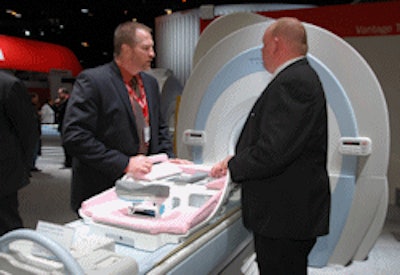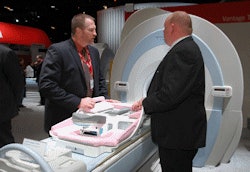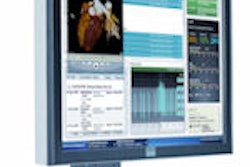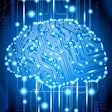
CHICAGO - New women's health products in several modalities are highlighted in the RSNA booth of Toshiba America Medical Systems, as the Tustin, CA, vendor also features recent research conducted with its 320-detector-row Aquilion One CT scanner.
CT
Toshiba's launch of the 320-detector-row Aquilion One scanner was a highlight of RSNA 2007, and the company is touting the system again this year. The vendor has shipped 70 of the super-premium scanners since its commercial launch and is spotlighting user experiences with the system in its RSNA booth.
One particular point of emphasis for Toshiba is radiation dose reduction; Aquilion One delivers lower radiation dose to patients as it acquires data in volumes, rather than using overlapping slices, the company claims. In pediatric imaging, Toshiba is highlighting the experiences of Aquilion One users who say the scanner is so fast they don't need to sedate children.
In new Aquilion One developments, the company is promoting a new lateral couch movement for the scanner's patient table that enables users to center patients for scanning. The company is also working on a pediatric patient positioning system, based on either a cradle or bean bag for children to rest in during scans.
In advanced clinical applications, Toshiba is touting SureCardio Prospective, its prospective gating cardiac imaging technique, and Variable Helical Pitch, which varies the table pitch down the body to reduce dose to organs that aren't the focus of the study.
Toshiba also announced that it is funding CorE 320, a follow-up to the company's Coronary Evaluation on 64 (CorE 64) study comparing coronary CT angiography (CTA) to catheter-based angiography. The CorE 64 results were published last week in the New England Journal of Medicine.
While one of the study's conclusions was that coronary CTA isn't ready to replace conventional angiography due to CT's low negative predictive value, Toshiba executives said they were heartened by several conclusions in the research, such as CT's ability to identify patients who went on to revascularization. The technology's low negative predictive value could have been a function of the higher prevalence of heart disease in the study population, they said.
Finally, Toshiba executives clarified the division of labor between the Voxar advanced visualization business that the company recently acquired and Toshiba's longtime 3D partner, Vital Images of Minnetonka, MN. The Voxar business, now called Toshiba Medical Visualization Systems (TMVS), will continue to develop clinical applications such as the company's SureCardio family, while Vital Images will develop consoles for Toshiba CT scanners. Toshiba has had a development partnership for a number of years with the Voxar business, which previously was owned by Barco of Kortrijk, Belgium.
MRI
Breast MRI procedure volume in the U.S. is up 100% over last year, and the rising level of interest has prompted Toshiba to release a new breast MRI package for its Vantage Atlas and Vantage Titan scanners. The Radiance Plus breast imaging suite includes a dedicated bilateral breast imaging coil developed by Sentinelle Medical of Toronto, as well as specialized breast scanning applications.
 |
| Toshiba is highlighting a new breast MRI capability for its Vantage scanners. |
In conjunction with the Radiance Plus package, Toshiba has developed a specialized MRI breast scanning package called k-space gadolinium-free breast imaging (KGB). The application combines Toshiba's fresh blood imaging (FBI) and time-SLIP protocols to enable breast MRI to be conducted without contrast, reducing the risk of a patient developing nephrogenic systemic fibrosis.
Toshiba is also promoting the patient friendliness of performing breast MRI with its scanners, which sport a 71-cm aperture and Pianissimo gradient-noise reduction technology. Radiance Plus will be available first on the company's flagship Vantage Titan scanner, and then on the mid-range Vantage Atlas in about six months.
In other news, Toshiba is also highlighting its Titan 3-tesla scanner as a work-in-progress, as well as the 700th installation of a Vantage scanner, at Comanche County Medical Center in Comanche, TX.
Ultrasound
Breast imaging is also a focus in the ultrasound section of Toshiba's booth, where the company is discussing an elastography application called ElastoQ as a work-in-progress on its Aplio XG scanner. Elastography can differentiate between malignant and benign tissue based on tissue stiffness and can be a useful tool as an adjunct to mammography.
Toshiba's version of elastography enables sonographers to collect data with five cycles of breast compression, and it also collects quantitative data on tissue stiffness. The company is still working on collecting clinical data for a 510(k) submission to the U.S. Food and Drug Administration (FDA).
Toshiba is also discussing the use of its MicroPure technique for detecting microcalcifications on breast ultrasound images. The technique filters speckle and surrounding tissue, making it easier to see calcifications. MicroPure has FDA clearance, and Toshiba is conducting clinical validation of the technique in conjunction with Northwestern University of Chicago.
Toshiba is also rolling out new high-definition transducers for breast imaging, including the 18-MHz Dynamic Micro Slice transducer.
For fetal heart imaging, Toshiba is showing a gating technique to assess the fetal heart called spatiotemporal image correlation (STIC). Using STIC, data are acquired via an automatic volume acquisition capturing a high number of 2D frames in a volume set. The resulting volume image displays a loop of the beating fetal heart.
Finally, Toshiba is migrating its differential tissue harmonic imaging (D-THI) technique to its Xario XG scanner. STIC is also being added to Xario XG.
X-ray
In x-ray, Toshiba is launching a new version of its Infinix-i angiography system designed for neurovascular use, with two 12-inch flat-panel digital detectors. The 12-inch detectors offer advantages over larger 16-inch panels in that they can be positioned closer to patients, Toshiba executives said.
The detectors can be rotated on the system's positioning arm, with up-and-down and left-to-right movements. The company will begin taking orders for the system in April.
Toshiba has also made enhancements to its Radrex-i digital radiography room, which incorporates a wall stand and table. The firm has added a tethered flat-panel detector to the system's table, which gives users additional positioning flexibility. Toshiba favors the tethered approach over wireless panels, which the company says have security issues. The mixed-detector configuration received 510(k) clearance last year, and Toshiba plans to begin shipping in February.
Toshiba plans to show a version of Radrex-i next year in which users can buy a single flat-panel detector to drive both the chest stand and table, offering a lower purchase price.
By Brian Casey
AuntMinnie.com staff writer
November 30, 2008
Related Reading
Toshiba buys Barco's AV assets, November 21, 2008
Toshiba gets 4D ultrasound sale, November 12, 2008
Toshiba adds Alabama install, November 10, 2008
Toshiba signs PinnacleHealth, November 3, 2008
Road to RSNA, Medical Displays, Barco, November 3, 2008
Copyright © 2008 AuntMinnie.com



















